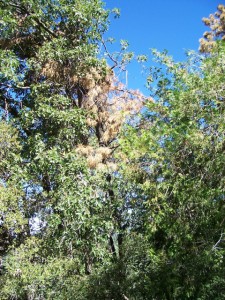By Marcia E. Gawecki
Driving up Hwy. 243 from Banning, you can see brown trees in the distance, where before there were only green ones. We had plenty of moisture in the spring, but now there are entire trees turning brown along the road side. Brown is a color that is too bold to ignore. Are the bark beetles back? Is Idyllwild going to lose thousands of trees like it did in 2003?
“It’s a natural process,” said Laura Verdugo, a visitors services information assistant, at the Idyllwild Ranger Station. “Trees die in the forest all the time from overcrowding or drought, but I don’t think what you’re seeing here is anything like what happened here in 2003.”
However, once she saw pictures of one tree that was brown in the middle, but green on top, she said that it could be a bark beetle causing its death. She motioned to a “Meet the Beetles” book on a nearby display.
“It’s for kids, but explains bark beetles pretty well,” Verdugo said.
The brightly-illustrated book only had five pages, but it was a wealth of information, even for adults. For example, there are four different types of bark beetles in these parts, each with a different MO and preference for pines.
The four beetles covered in the book include: the pine engraver beetle, the red turpentine beetle, the western pine beetle and the jeffrey pine beetle. They show a close-up of the beetle, next to a tree that also shows the beetle’s markings.
The book is written for young adults with zippy language. Here’s an example of the red turpentine beetle:
Favorite food: Ponderosa Pine
Measurements: 3/8 inch at adulthood
Colors: reddish brown
“I was here” tag: Reddish pitch tubes (small wads of resin on the tree trunk)
Special skill: Capable of flying more than 10 miles
After reading one particular page, Verdugo said that it looked like it was the Western Pine Beetle that was likely killing the Coulter Pines along Hwy. 243. This beetle’s “attack position” is usually midway up the tree trunk.
It’s “worst nightmares” (or predators) are woodpeckers and checkered beetles, the book said.
“I didn’t know that certain beetles ate each other,” Verdugo said.
She added that many locals and visitors bring in bark beetles to the Ranger Station, to help identify them.
“But most of the beetles they bring in aren’t bark beetles,” she said. “They’re way too big. You can see them from across the room.”
She explained that bark beetles are incredibly small, measuring 1/8 to 3/8 of an inch.
“The beetle pictures are nice, but they should have put a beetle in its actual size,” she added.
Verdugo said that one of the employees at the Ranger Station put the book together, but she wasn’t sure if it was available online.
IN RELATED NEWS:
On Tuesday morning, August 10, there was road construction along Hwy. 243 from Idyllwild towards Banning near the Silent Valley Club. The highway is restricted to one lane, with an “escort” truck. There is a modest wait (about 15 minutes).
Several bulldozers and trucks are creating a new pullout space, and smoothing the road’s edge. If you plan on going down to Banning or Palm Springs today, you might consider adding some extra driving time.

the attachments to this post:











